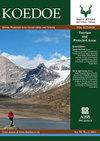气候变化和狩猎的所有权:对围栏野生动物区的关注
IF 1.1
4区 环境科学与生态学
Q3 BIODIVERSITY CONSERVATION
引用次数: 4
摘要
气候变化越来越多地被认为是生物多样性保护面临的主要挑战之一(Bellard et al. 2012),随着这一认识的实现,保护区和其他受保护的自然区域(即狩猎农场和牧场)作为避难所以及野生动物的“岛屿栖息地”受到了更大的重视。尽管这种观点可能适用于有保护区的开放系统,至少在那里,野生动物可以自由地移动到保护区的边界之外,但它可能不适用于围栏区域,就像南非的主要情况一样,在某种程度上限制了物种对气候变化的反应。在这种情况下,建议将因气候变化而流离失所的物种物理迁移到更适合栖息地的地区,或建立科学文献中丰富的生物多样性或野生动物走廊(Davidson et al. 2012;迪敏宁等,2013;Groves et al. 2012;哈特,高盛&索斯沃思2011;Lister et al. 2015;马登2008;麦克道尔2013;Minteer & Collins 2010;Pittiglio et al. 2014;萨克斯,史密斯和汤普森2009;Schwartz et al. 2012;Songhurst et al. 2016;Syombua 2013;特里尔2009;Wilke & Rannow 2014)。尽管这一论点从许多角度来看都是合理的,但在一个物种被提取并重新引入其他地方,或者建立稳定有效的走廊之前,可能需要克服许多社会、经济、保护、法律和实践方面的挑战。本文章由计算机程序翻译,如有差异,请以英文原文为准。
Climate change and the ownership of game: A concern for fenced wildlife areas
Climate change is increasingly being cited as one of the major challenges facing the conservation of biodiversity (Bellard et al. 2012), and with this realisation a greater emphasis is being placed on protected areas and other conserved natural areas (i.e. game farms and ranches) as refugia as well as ‘island habitats’ for wildlife. Although this argument may hold in open systems within which protected areas occur and where, at least, wildlife may freely move beyond the boundary of the conserved area, it may not hold for areas that are fenced, as is predominantly the case in South Africa, in a manner that limits the movement of species responding to climate change. In such circumstances, the recommendation is to physically relocate climate change-displaced species to areas of more suitable habitat, or establish biodiversity or wildlife corridors that are abundant in the scientific literature (Davidson et al. 2012; Di Minin et al. 2013; Groves et al. 2012; Hartter, Goldman & Southworth 2011; Lister et al. 2015; Madden 2008; McDowell 2013; Minteer & Collins 2010; Pittiglio et al. 2014; Sax, Smith & Thompson 2009; Schwartz et al. 2012; Songhurst et al. 2016; Syombua 2013; Treves 2009; Wilke & Rannow 2014). Although this argument is sound from many perspectives, there are a number of social, economic, conservation, legal and practical challenges that may need to be overcome before a species can be either extracted and re-introduced elsewhere, or stable and effective corridors can be established.
求助全文
通过发布文献求助,成功后即可免费获取论文全文。
去求助
来源期刊

Koedoe
BIODIVERSITY CONSERVATION-
CiteScore
3.30
自引率
0.00%
发文量
10
审稿时长
20 weeks
期刊介绍:
Koedoe, with the subtitle ''African Protected Area Conservation and Science'', promotes and contributes to the scientific (biological) and environmental (ecological and biodiversity) conservation practices of Africa by defining the key disciplines that will ensure the existence of a wide variety of plant and animal species in their natural environments (biological diversity) in Africa.
 求助内容:
求助内容: 应助结果提醒方式:
应助结果提醒方式:


